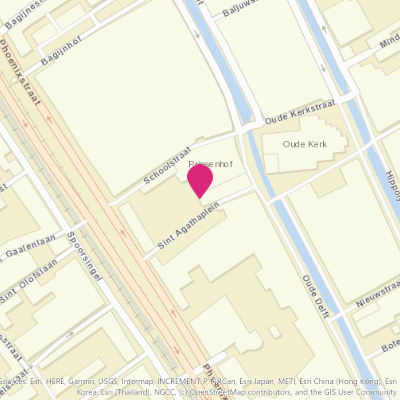Walking through Delft is a feast for the eyes. Find the beautiful historic buildings, bridges, squares, and almshouse courtyards that all tell their own stories. At the same time, be surprised by the city’s contemporary character that constantly hints at its history.
Are you interested in finding out more about Delft’s highlights that you really should explore? We have put together a must-see top 6 so you won’t miss any of them!
1. Oostpoort
The magnificent Oostpoort (East Gate) is the only city gate still standing and without a doubt one of the picture postcard photographs for your photo album of your trip to Delft. Around 1400, Delft had built its city walls with eight gates. The city gates were the only access routes into Delft and, thus, easy to defend against aggressors.
The high city walls, gates, moats, and earthworks were also the reason why William of Orange chose Delft as his domicile in 1572. The Oostpoort consists of a land gate and a water gate, connected by the last remnants of the city walls.

2. Oude en Nieuwe Kerk
As you arrive in Delft, you will soon see these two massive buildings towering above the city centre: the Oude Kerk (Old Church) and the Nieuwe Kerk (New Church). As the name implies, the Oude Kerk is the oldest and was completed in 1246. And it’s not just its age that makes this church so special – it is leaning! Back in the day, the people of Delft didn’t know much about the ground layers on which they were building the tall tower. As it started to lean, the church got its nickname “Scheve Jan”, meaning Leaning John.
Another impressive iconic building in Delft is the Nieuwe Kerk on the Markt square. This church not only is the second tallest church in the Netherlands, but it also holds the royal family’s tomb. The church has had its fair share of damage, including the several times it was struck by lightning.
After the last impact, the tower was rebuilt with Bentheim sandstone, which was not resistant to acid rain and just blackened over the years. And yet, this impressive monument stands the test of time and will continue to do so for many years to come.
TIP! Weather permitting, you can climb the tower and enjoy the splendid city views!


3. Delft's City Hall
Opposite the Nieuwe Kerk, you find Delft’s historic city hall. The original building dates back to 1200 and was nearly completely destroyed during a fire in 1618. The only part that remained was the tower called ‘Het Steen’. The tower was used as a prison, and its most notorious prisoner was Balthasar Gerards, who murdered William of Orange.
After the fire, the renowned Renaissance architect Hendrick de Keyser was commissioned to rebuild the city hall around the tower. De Keyser was one of the best architects of his time and he also designed the mausoleum erected for William of Orange in the Nieuwe Kerk – another architectural highlight. Today, the Delft municipal council still works at the City Hall.

4. Sint Agathaplein
It’s safe to say that St. Agathaplein is Delft’s cultural courtyard. The name derives from the Saint Agatha convent, which now houses the Museum Prinsenhof Delft. The St. Agathaplein offers access to the Museum Prinsenhof Delft and the ‘Prinsenkwartier’.
Attention! Museum Prinsenhof Delft will be temporarily closed for renovations from January 6th 2025. For more information, please visit the website of Museum Prinsenhof Delft.

5. Molen de Roos
In the old days, Delft had 18 working windmills. Now there’s only one left: windmill De Roos. De Roos still works entirely on wind power and grinds organic grain to flour. The mill is open to visitors and its upper deck offers great views of the city.



6. Het Kruithuis
As the name shows, the Kruithuis (Powder House) on the Delftse Schie used to be a storage facility for gunpowder. The now-listed building was built on the Schiekade in 1660, far from the city centre. On 12 October 1654, the day that would go down in history as the ‘Delft Thunderstrike’, the people of Delft learned a disastrous lesson when a huge storage on the Geerweg, right in the city centre and filled with gunpowder, exploded. So when a new powder house had to be built, the city’s governors quickly decided that the new Kruithuis had to be erected well outside the city walls, along the river Schie.


























